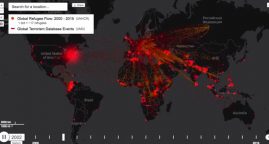Fact-checking John Kerry’s speech on the Israeli-Palestinian conflict
Article published on Washington Post website on 03/01/2017
“It’s important to note that every United States administration, Republican and Democratic, has opposed settlements as contrary to the prospects for peace.” Secretary of State John F. Kerry, remarks on Middle East peace, Dec. 28. 2016
Fact-checking the Israeli-Palestinian conflict is a bit of a fool’s errand. The two sides have their own narratives, which are virtually impossible to reconcile. Meanwhile, supporters of Israel in the United States — and even Israelis — have also split into seemingly irreconcilable camps, with their own sets of facts and assumptions about the root causes of the conflict.
Even before he became president, President Obama has long been part of the camp that believes Israeli settlements in the West Bank are a key impediment to a peace deal. As soon as he became president, Obama took a tough stand on settlements and quickly forced a confrontation with the Israeli government of the newly elected Prime Minister Benjamin Netanyahu. Obama believed such a gesture would help bolster Arab support for the peace process.
Obama’s efforts did not result in a peace deal — or a good relationship with the Netanyahu government. In fact, a case could be made that demanding a freeze in settlements as a precondition for negotiations with the Palestinian Authority undermined the administration’s diplomacy from the start, since that had never before been a condition for peace talks.
Secretary of State Kerry on Dec. 28 once again focused on Israeli settlement expansion in a swan-song speech given just days after the United States infuriated Netanyahu by abstaining on a U.N. Security Council resolution that condemned Israeli settlements. The abstention allowed the resolution to pass. Since Kerry’s speech is an argument in favor of the administration’s position, he glosses over or ignores some contrary information.
Below is a fact check of some of the key statements in Kerry’s speech. As this is a roundup — and many of these issues are open to debate — we will not assign Pinocchios.
“It’s important to note that every United States administration, Republican and Democratic, has opposed settlements as contrary to the prospects for peace. And action at the U.N. Security Council is far from unprecedented. In fact, previous administrations of both political parties have allowed resolutions that were critical of Israel to pass, including on settlements.”
In diplomacy, a possible sign that something new has happened is when diplomats breathlessly insist that there is precedent for the action. UNSC Resolution 2334 had this key section, as its first operative paragraph:
“Reaffirms that the establishment by Israel of settlements in the Palestinian territory occupied since 1967, including East Jerusalem, has no legal validity and constitutes a flagrant violation under international law and a major obstacle to the achievement of the two-State solution and a just, lasting and comprehensive peace”
For many Israelis, the reference to East Jerusalem as occupied Palestinian territory was especially galling, since it contains the Western Wall. The wall, close to destroyed ancient temples, is the holiest site where Jews are permitted to pray and is said to be a part of a retaining wall of the structure of the Second Temple. (The Wall is adjacent to the Jewish quarter of the Old City of Jerusalem, which was held by Jordan until 1967 Six-Day War.) The Palestinians claim East Jerusalem as the capital of an eventual Palestinian state, although various peace proposals have suggested that Israel would have sovereignty over the old Jewish Quarter.
Also problematic for supporters of Israel is the reference to 1967, since the original land-for-peace UNSC resolution (242) purposely did not mention specific lines or even Jerusalem, according to the U.S. ambassador to the United Nations at the time. (Arab states and Russia had sought such language in 242, which the United States rejected.)
The administration can point to 25 UNSC resolutions, between 1971 and 1994, that included some reference to Jerusalem, 1967 or occupied territories. In virtually all cases, the reference was not in an operative paragraph but in the preamble; many of these resolutions were on distinct events (such as the shooting of Palestinian youth or expulsions of Palestinians) that had alarmed the international community. There also was no specific reference to “East Jerusalem.”
The last time a resolution was approved by the Security Council with phrasing concerning Jerusalem and occupied territories in a key operative paragraph was in 1980 — during the Jimmy Carter administration, when Obama was a college student. (Note: There were two resolutions in 1988 that slipped the language into the obligatory paragraph saying the Security Council would keep the matter under review.) So Kerry is reaching back decades to find precedent for the administration’s abstention.
Back in 1980, the Israelis and Palestinians were not even negotiating directly. Since then, the Oslo Accords of 1993 between Israel and the Palestine Liberation Organization set in place a process under which settlements were to be discussed and negotiated as part of final status negotiations. That’s a key reason no resolution was passed with even this language in the preamble between 1994 and now. The last time, in 1994, the United States sought a rare paragraph-by-paragraph vote on the resolution to make clear its opposition to the Jerusalem language.
Indeed, then-U.N. Ambassador Madeleine Albright said the United States would oppose the assertion of Jerusalem as “occupied” in future resolutions because it was a matter for negotiations:
“We simply do not support the description of the territories occupied by Israel in the 1967 war as ‘occupied Palestinian territory.’ In the view of my Government, this language could be taken to indicate sovereignty, a matter which both Israel and the PLO have agreed must be decided in negotiations on the final status of the territories. As agreed between them, those negotiations will begin not later than two years after the implementation of the Declaration of Principles.”
Obviously none of the expected timetables under the Oslo Accords has worked out, but Israel did dismantle all settlements in the Gaza Strip in 2005 under a deal brokered by the George W. Bush administration. (Hamas later seized control of Gaza and started raining rockets on Israeli towns.)
“Albright’s stated concern in 1994 that the phrase ‘occupied Palestinian territory’ could imply an assertion or recognition of sovereignty appears to have been specific to the particular time period the statement was delivered,” an Obama administration official said.
The official added that “the U.S. has not changed its long-standing policy and practice that recognizes these areas, including East Jerusalem, as occupied territories, consistent with the reality on the ground, international law, and a desire not to prejudge their status, to the detriment of future negotiations.” As examples of this consistent policy, the official pointed to language in the State Department’s annual human rights report and in a 1989 letter from Assistant Secretary of State for Legislative Affairs Janet G. Mullins to then-Rep. Lee H. Hamilton (D-Ind.). “The long-standing position of the United States is that the law of belligerent occupation applies to East Jerusalem, which was occupied by Israel in 1967,” the letter said.
Kerry is right that every administration “opposed settlements as contrary to the prospects for peace.” But he’s wrong to paint all administrations with the same brush, as sometimes the language (such as in the Ronald Reagan years) was as mild as saying settlements were “not helpful” — not that they were illegal.
When Obama took office, the Israelis believed they had an agreement with the Bush administration, reached in 2004, to allow for continued settlement growth in areas that Israel would expect to retain in a peace deal. But Obama administration officials refused to acknowledge there was any such deal between the two countries and pushed for a full freeze. Netanyahu ultimately agreed to a partial, temporary freeze, but Palestinians said it had too many loopholes, and they did not return to negotiations.
In his focus on Israeli settlements, Kerry did not mention that during the second Bush administration and the Clinton administration, Palestinian negotiators were said to have rejected proposals from Israeli prime ministers that would have resulted in a Palestinian state, after land swaps that allowed the Israelis to keep major settlements. None of the proposals, however, would have resulted in 100 percent of the West Bank going to the Palestinians; Israel wanted to keep at least 6 percent in order to retain the largest settlements. Palestinian officials also say the offers were vague and contained unacceptable conditions and restrictions.
“No American administration has done more for Israel’s security than Barack Obama’s.”
Kerry backs this up by citing military exercises, support for the Iron Dome defense system and a recently concluded $38 billion, 10-year military assistance program. But he does not mention Israel’s deep skepticism of the Iranian nuclear deal, which supporters of Israel say will weaken its long-term security if, despite administration assurances to the contrary, it ends up providing Tehran with a path to a nuclear weapon.
“More than 1/2 of our entire global foreign military financing goes to Israel.”
This is correct. In 2015, $3.1 billion out of a total of $5.65 billion went to Israel. In fact, another $1.3 billion went to Egypt, so the countries combined receive 78 percent of U.S. foreign military aid. The military aid to Egypt was a major component of the Camp David accords that established peace between the two countries.
“Compounding this, the humanitarian situation in Gaza exacerbated by the closings of the crossings is dire.”
Kerry appears to suggest crossings are closed into Gaza, which would be incorrect. Israel recently has allowed more trade to pass through the crossings, though it is still significantly below the levels before the second Palestinian uprising began in 2000. The State Department says Kerry is referring to reductions in the goods crossing between Israel and the Gaza Strip, even though the population is believed by Palestinian sources to have increased by 40 percent since Hamas seized control of the enclave in 2005. The United States has designated Hamas a terrorist group.
There are three operational crossings allowing access of people and goods in and out of Gaza. The Erez passenger crossing and Kerem Shalom commercial crossing are controlled by Israel, while the Rafah crossing is controlled by the Egyptians. Rafah has been closed most of the time since the summer of 2013, so Erez is essentially Gaza’s only gateway to the outside world.
On a monthly average basis, 14,000 exits by Palestinians were recorded at Erez in 2016 —compared with more than half a million exits in the months preceding the Second Intifada in 2000, according to Gisha, an Israeli human rights organization that tracks Gaza trade and which was cited by the State Department. Moreover, the number of exits in October — 7,101 — was half the level in May.
Kerem Shalom is the only crossing through which goods move in and out of Gaza. In the January-June 2016 period, a monthly average of 10,892 truckloads entered Gaza through Kerem Shalom, compared with about 12,000 trucks per month that entered Gaza in early 2007, according to Gisha.
In November 2014, for the first time since June 2007 (barring limited exceptions), Israel allowed a shipment of goods to exit Gaza for sale in the West Bank. In March 2015, it began allowing tomatoes and eggplants from Gaza to be sold in Israel for the shmita (Sabbath) year. During the first six months of 2016, an average of 175 truckloads of goods exited Gaza each month, or 16 percent of what exited monthly prior to 2007. Between January and November 2016, a total of 1,831 truckloads left Gaza to the West Bank, Israel and abroad, Gisha says.
“It is important that polls of Israelis and Palestinians show there is still strong support for the two-state solution in theory.”
Note that Kerry adds the words “in theory.” That’s because the poll he cited found only a bare majority of Palestinians — 51 percent — supported the creation of an Israeli state and a Palestinian state. (Among Israeli Jews, support was at 53 percent.)
Support fell to just 39 percent among Palestinians and Israeli Jews when the survey outlined the parameters of a peace deal, including a demilitarized Palestinian state, Israeli withdrawal to pre-June 1967 lines with equal territorial exchange, family reunification of 100,000 Palestinian refugees and Palestinian sovereignty over East Jerusalem, except for the Jewish Quarter.
In other words, Kerry’s claim of “strong support” for the two-state solution is overstated.
“The settler population in the West Bank alone, not including East Jerusalem, has increased by nearly 270,000 since Oslo. Including 100,000 just since 2009 when President Obama’s term began.”
If you do the math, that means the population growth rate in the settlements is nearly 4 percent. Israel’s overall population growth rate is about 2 percent. Israel has the highest birthrate in the industrialized world, especially among the Jewish Orthodox population that tends to live in settlements. Israelis have long maintained that “natural growth” — births — should be allowed in settlements, and even the ill-fated “road map” plan for peace pressed by President George W. Bush called for a freeze that included natural growth.
“There are over 100 of these [illegal] outposts and since 2011, nearly 1/3 of them have been or are being legalized despite pledges by past Israeli governments to dismantle many of them.”
Kerry is relying on a 2016 report by Yesh Din, an Israeli human rights organization, which says that “over a quarter of the outposts have been authorized or are undergoing various stages of authorization. Only four of these were retroactively authorized as independent settlements. The rest of the outposts were authorized or are undergoing authorization as neighborhoods or extensions of existing settlements.” The group says many of these outposts were built entirely or partly on privately owned Palestinian land.
“There are currently about 2.75 million Palestinians living under military occupation in the West Bank. . . . We also know that there is some 1.7 million Arab citizens who call Israel their home.”
There appears to be some double-counting of the 300,000 Arabs who live in East Jerusalem. Israelis include them in the figure for the 1.7 million, while Palestinians include them in the 2.75 million West Bank figure. (More than 90 percent of Palestinians in East Jerusalem have the status of permanent residents of Israel, which means they cannot vote in Israeli parliamentary elections. About five percent have become Israeli citizens.) Some experts have questioned the population estimates of the Palestinian populations on the West Bank and in Gaza, saying they are overstated.
“In 1978, the State Department legal adviser advised the Congress of his conclusion that Israel’s government program establishing civilian settlements in the occupied territory is inconsistent with international law. And we see no change since then to affect that fundamental conclusion.”
Kerry is correct that the legal opinion was never officially withdrawn, but here again the administration is reaching back to the Carter years. Later administrations concluded that reaffirming this language would complicate future peace talks.
Interestingly, in 2009, the Obama administration pointedly refused to say whether it still regarded the Carter-era memo as operative. But The Washington Post noted at the time that the administration’s tough stance on settlements indicated the decades-old opinion “might have new relevance.”
“Over 1,300 Palestinians including over 600 children have been displaced by demolitions in 2016 alone — more than any previous year.”
These numbers come from the U.N. Office for Coordination of Humanitarian Affairs. Data through Dec. 30 for the West Bank is 1,326 people, including 627 children.
“We were the only administration since 1967 that had not allowed any resolution to pass that Israel opposed.”
This obviously was no longer correct once the administration decided to abstain on Resolution 2334.
“Recognition of Israel as a Jewish state has been the U.S. position for years.”
It appears to have become the U.S. position almost by accident. An Israeli diplomat slipped the phrase into a speech given by then-Secretary of State Colin Powell in 2001, but few U.S. officials at the time understood its possible importance in future diplomacy. The Israelis, who were surprised at how hard Palestinians had pushed the refugee issue at the Camp David talks in 2000 and at Taba in 2001, pressed the issue because they wanted to ensure that Palestinians did not have a right to return to Israel. Once the phrase appeared in Powell’s speech, it was adopted by other U.S. officials and, with the encouragement of Israeli officials, became U.S. policy — although Palestinians say it is a nonstarter.
John Kerry integral speech (video)
Learn more
Resolution 2334 (2016) Adopted by the Security Council at its 7853rd meeting, on 23 December 2016
Related Articles
5 natural disasters that beg for climate action
Climate hazards are natural events in weather cycles. We are currently witnessing a scale of destruction and devastation that is new and terrifying.
Libyan delegation in Rome to discuss immigration and mutual challenges
10/08/2015. Meeting of senior representatives from Tobruk and Tripoli takes place at Order of Malta Magistral Villa
Safe havens: why cities are crucial to the global refugee crisis
06/06/2017. The world is facing unprecedented levels of population displacement. At least 65 million people are on the move, including 21.3 million refugees and 31 million internally displaced persons since the beginning of 2016.






